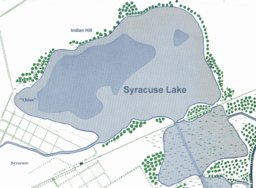Syracuse Lake facts for kids
Quick facts for kids Syracuse Lake |
|
|---|---|

1910 map of Syracuse Lake
|
|
| Location | Kosciusko County, Indiana, United States |
| Coordinates | 41°25′36″N 85°44′13″W / 41.4266°N 85.7369°W |
| Basin countries | United States |
| Surface area | 1.67 km2 (414 acres) |
| Average depth | 3.9 m (13 ft) |
| Max. depth | 10 m (34 ft) |
Syracuse Lake is a natural lake right next to the town of Syracuse in Kosciusko County, Indiana, United States. It's a popular spot for both people who live there all year and those who visit for fun during different seasons.
Contents
Where is Syracuse Lake?
Syracuse Lake is easy to find! On its west side, you'll see N. Front Street, Pickwick Road, and the B&O Railroad. To the east, there's E. Shore Drive, and E. Northshore Drive is on the north side. A cool channel connects Syracuse Lake to its bigger neighbor, Lake Wawasee, on the south end.
How Healthy is the Lake?
Syracuse Lake is a healthy lake with a good balance of plants and animals living in its water. It has a surface area of about 1.67 square kilometers (414 acres). The deepest part of the lake is about 10 meters (34 feet), and its average depth is around 3.9 meters (13 feet).
A Look Back in Time: Lake History
Before the Ice Age
About 1 million years ago, long before the last Ice Age, a huge river system called the Teays River flowed through northern Indiana. This river came from Virginia, West Virginia, and Ohio. It flowed about 49 miles south of where Syracuse Lake is today.
After the Ice Age
When the last Ice Age ended, giant glaciers melted and left behind the land we see today. They created bowl-shaped holes called kettle holes and hilly areas called moraines. The land was covered in thick forests of evergreen trees like spruce, and also balsam poplar, oak, and hickory trees.
Many amazing animals lived here, including giant armadillo-like creatures called Glyptodon, saber-toothed cats, mastodons, short-faced bears, dire wolves, ground sloths, giant beavers, and ancient bison. The lakes were full of fish like sturgeon, whitefish, pike, and muskellunge.
Early People at the Lake
The area around Syracuse Lake was first settled by people from the Glacial Kame culture. These early people left behind interesting tools and burial sites.
The Syracuse Dugout Canoe
In 1959, a man named Dick Jamison was fishing in Syracuse Lake. He saw something strange underwater, about 4 or 5 feet deep. It looked like a big, waterlogged log. When he and his father pulled it out, they found it was a blackened dugout canoe!
This canoe was made from a tulip tree and measured 21 feet (6.4 meters) long and 3 to 4 feet (91 to 121 cm) wide. Most of its sides had rotted away over time. People think it might have belonged to the Miami Indians, fur traders, or very early settlers. It was likely left on the lake's old shore before a dam was built in 1834, which raised the lake's water level.
Indian Hill Cemetery
On the north shore of Syracuse Lake, about 1.5 miles east of Syracuse town, is a place called Indian Hill. This was a cemetery where local Native Americans buried their dead in trees. Over time, the coverings around the bodies would break down, and the skeletal remains would fall to the ground.
Stories of Giant Sturgeon
People have told stories about huge sturgeon in Syracuse Lake:
- In 1912, a man named Bing Raymond caught a 32-inch sturgeon near the northwest side of the lake.
- Around the same year, four men saw another sturgeon in the lake.
- In the 1920s, Charlotte White found a very large sturgeon that was 7 feet, 3 inches long and weighed 130 pounds. Sadly, it had suffocated because a pair of waterwings got caught in its gills.
Images for kids




